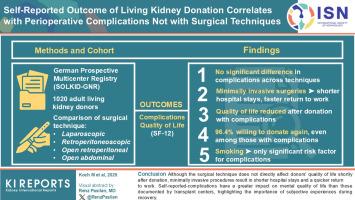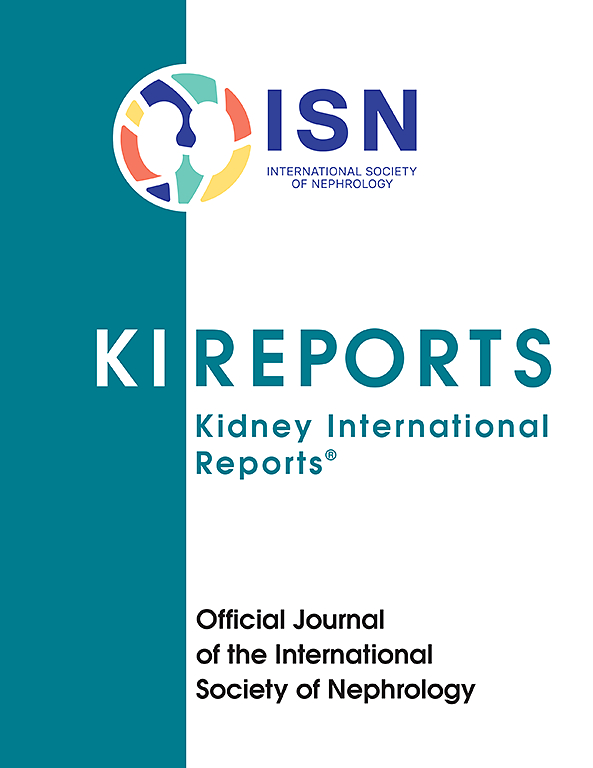活体肾脏捐献的自我报告结果与围手术期并发症相关,而与手术技术无关
IF 5.7
2区 医学
Q1 UROLOGY & NEPHROLOGY
引用次数: 0
摘要
德国卫生保健系统缺乏活体供体手术并发症和自我报告结果(sro)的数据。solkidg - gnr是一项前瞻性的德国活体肾脏捐赠者登记项目,旨在改善对捐赠者医疗和社会心理风险的评估。方法收集移植中心(tc)活体肾脏捐献前(PRE)和捐献后3个月(POST)的数据。我们报告了不同手术技术的围手术期并发症发生率,并将其与供体sro相关联。分析了来自30个德国tc的1020名献血者的数据集。结果供体肾切除术方式包括腹腔镜(57.9%)、腹膜后镜(21.4%)、开放式腹膜后肾切除术(16.0%)和开放式腹部肾切除术(4.7%)。tc报告的围手术期并发症从9.8%(后腹膜镜)到17.1%(开腹)不等,而供体报告的围手术期并发症从12.2%(后腹膜镜)到15.0%(开腹)不等。在微创手术后,供体更早出院,更早重返工作岗位;然而,捐赠后的生活质量(QoL)相当。捐献后4种手术方式的物理成分总结(PCS)短表12 (SF-12)评分相似;然而,有TC或自我报告并发症的献血者比没有TC或自我报告并发症的献血者低。仅在自我报告并发症的情况下,SF-12的心理成分总结(MCS)得分较低。尽管有12.5%的人自我报告出现并发症,但96.4%的人表示愿意再次捐赠,94.1%的人表示了解情况。结论手术技术虽不直接影响献血者捐献后不久的生活质量,但微创手术可缩短患者的住院时间,更快地恢复工作。自我报告的并发症比移植中心记录的并发症对精神生活质量的影响更大,突出了康复期间主观经历的重要性。本文章由计算机程序翻译,如有差异,请以英文原文为准。

Self-Reported Outcome of Living Kidney Donation Correlates With Perioperative Complications not With Surgical Techniques
Introduction
The German health care system lacks data on surgical complications and self-reported outcomes (SROs) of living donors. The prospective German Living Kidney Donor Registry, SOLKID-GNR aims to improve the assessment of donors’ medical and psychosocial risks.
Methods
Data were collected before (PRE) and 3 months after (POST) living kidney donation from transplantation centers (TCs) and donors via SROs. We reported perioperative complication rates for different surgical techniques and correlated them with donors’ SROs. Datasets of 1020 donors from 30 German TCs were analyzed.
Results
Donor nephrectomy procedures included laparoscopic (57.9%), retroperitoneoscopic (21.4%), open retroperitoneal (16.0%), or open abdominal nephrectomy (4.7%). Perioperative complications reported by TCs ranged from 9.8% (retroperitoneoscopic) to 17.1% (open abdominal), whereas those reported by donors ranged from 12.2% (open retroperitoneal) to 15.0% (open abdominal). Donors were discharged sooner and returned to work earlier after minimally invasive surgery; however, had comparable quality-of-life (QoL) after donation. The physical component summary (PCS) scores of the Short Form–12 (SF-12) were similar between the 4 surgical methods postdonation; however, they were lower in donors with TC- or self-reported complications than in those without. The mental component summary (MCS) scores of the SF-12 were lower in case of self-reported complications only. Despite 12.5% of self-reported complications, 96.4% expressed a willingness to donate again, and 94.1% felt well-informed.
Conclusion
Although the surgical technique does not directly affect donors' QoL shortly after donation, minimally invasive procedures result in shorter hospital stays and a quicker return to work. Self-reported complications have a greater impact on mental QoL than those documented by transplant centers, highlighting the importance of subjective experiences during recovery.
求助全文
通过发布文献求助,成功后即可免费获取论文全文。
去求助
来源期刊

Kidney International Reports
Medicine-Nephrology
CiteScore
7.70
自引率
3.30%
发文量
1578
审稿时长
8 weeks
期刊介绍:
Kidney International Reports, an official journal of the International Society of Nephrology, is a peer-reviewed, open access journal devoted to the publication of leading research and developments related to kidney disease. With the primary aim of contributing to improved care of patients with kidney disease, the journal will publish original clinical and select translational articles and educational content related to the pathogenesis, evaluation and management of acute and chronic kidney disease, end stage renal disease (including transplantation), acid-base, fluid and electrolyte disturbances and hypertension. Of particular interest are submissions related to clinical trials, epidemiology, systematic reviews (including meta-analyses) and outcomes research. The journal will also provide a platform for wider dissemination of national and regional guidelines as well as consensus meeting reports.
 求助内容:
求助内容: 应助结果提醒方式:
应助结果提醒方式:


